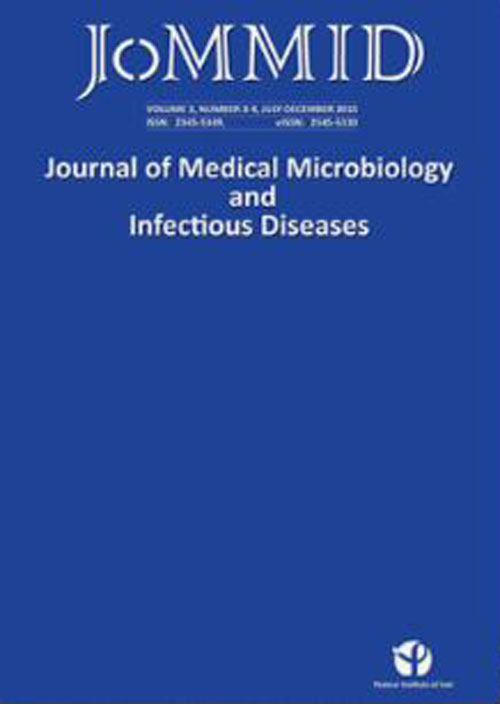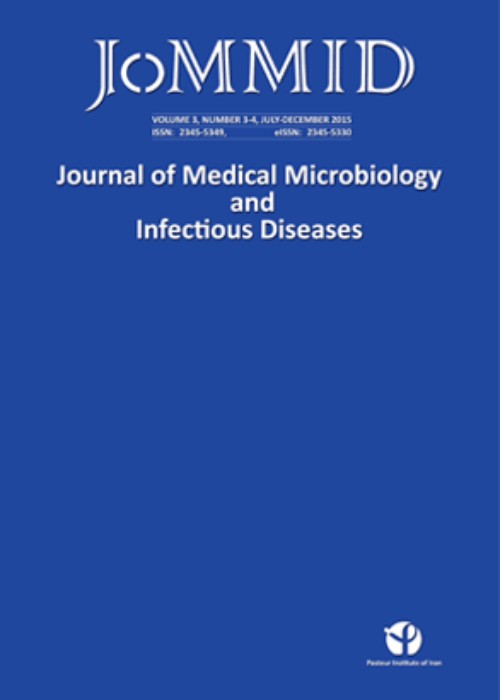فهرست مطالب

Journal of Medical Microbiology and Infectious Diseases
Volume:10 Issue: 2, Spring 2022
- تاریخ انتشار: 1401/03/21
- تعداد عناوین: 8
-
-
Pages 48-53Introduction
Antimicrobial resistance is one of the most significant challenges globally that threatens our ability to treat infectious diseases. This study investigated Streptococci and Enterococci in dental caries and healthy individuals and determined antibiotic resistance in the recovered bacteria.
MethodsOne hundred and twelve samples were collected, 56 from patients with dental caries and 56 samples from the teeth and saliva of healthy people. The samples were cultured on blood agar and purified on Mitis Salivarius agar. All isolates were identified by biochemical tests and Vitek 2 system and then examined for antibiotic susceptibility by disc diffusion method.
ResultsStreptococci and enterococci were the most isolated agents from dental caries and the teeth and saliva of healthy people. Streptococcus spp. comprised 48.61% of bacteria in dental caries and 28.40% in healthy individuals, while Enteroccus spp. was 22.22% in dental caries and 30.84% in healthy individuals. Streptococcus mutans and Streptococcus salivarius were more prevalent in dental caries and healthy individuals, respectively, while Enterococcus faecium was detected in both dental caries and healthy individuals. Also, there were significant differences between the number of streptococci isolated from healthy and caries people (P<0.05). In isolates recovered from healthy people, the streptococcal spp. exhibited high resistance to azithromycin (82.6%), cefixime and tetracycline (91.3%), and amoxicillin (60.8%). In contrast, enterococci were resistant to tetracycline (92%) and cefixime (76%). In dental caries isolates, the streptococcal and enterococcal spp. showed the highest resistance to amoxicillin (> 68%).
ConclusionsThe streptococcal and enterococcal spp. comprised the most isolated bacteria from healthy individuals and dental caries and exhibited multidrug resistance.
Keywords: Streptococci, Enterococci, Dental caries, Antibiotic resistance -
Pages 54-57Introduction
Worldwide, food handlers play a vital role in spreading intestinal infections. Poor personal hygiene and inadequate knowledge of food safety among food handlers working in food-serving establishments would make the food handler a potential source of infection of enteropathogenic bacteria, many intestinal helminths, and protozoa. The purpose of the study was to assess the prevalence of bacteria and intestinal parasites in food handlers working in our institution.
MethodsThe study was conducted in the Department of Microbiology, T.S. Misra Medical College & Hospital, Lucknow, Uttar Pradesh, India, and included 100 food handlers working in various institutional sections. The stool samples were collected from all participants and examined by microscopy for intestinal parasites. For detecting Salmonella spp, specimens were cultured on selenite F broth and xylose lysine deoxycholate.
ResultsMost food handlers (85%) were 21-25 years old. Twenty-six (26%) of the food handlers had parasitic infections, while bacterial infections were detected in none. The dominant parasite among food handlers was Giardia lamblia, followed by Ascaris lumbricoides.
ConclusionFood handlers must undergo regular checkups to identify infected employees to safeguard the health of patients, visitors, and health care workers.
Keywords: Ascaris lumbricoides, Salmonella spp., food-borne illness, Giardia lamblia -
Pages 58-63Introduction
COVID-19 ocular manifestations commonly occur in adults; however, there is limited data on this manifestation in children. This systematic review and meta-analysis investigated the prevalence of ocular manifestations in children.
MethodsWe searched PubMed, Scopus, EMBASE, Web of Science, and MedRxiv from December 1, 2019, to February 3, 2021. Two independent reviewers screened the articles, extracted the data, and assessed the quality of the articles.
ResultsAfter screening 1,510 articles, 19 were approved and included in the systematic review and meta-analysis. The literature review showed that 89 out of 749 children with COVID-19 had at least one ocular manifestation. The estimated pooled prevalence of ocular manifestations was 8.0% (95% confidence intervals 4.0 – 12.0). The most common symptoms were conjunctival discharge (n = 31, 23.1%), conjunctival congestion (n = 21, 16.0%), eye rubbing (n = 19, 14.2%).
ConclusionOcular manifestations are common in children with COVID-19; one out of 14 infected children shows at least one ocular manifestation. Physicians should pay attention to the ocular manifestations associated with COVID-19 in children.
Keywords: COVID-19, Children, Ocular Manifestations, Conjunctivitis, Systematic Review -
Pages 64-74
The term "Nosocomial" is attributed to the diseases acquired by the patient under medical care. Various microorganisms, including bacteria, viruses, and fungi, may contribute to developing nosocomial infections (NIs). Urinary tract infections (UTI), surgical-site infections (SSI), bloodstream infections (BSI), and pneumonia are the most well-known instances. We investigated various aspects of NIs and the main causative agents of NIs, particularly bacteria, antibiotic resistance, crucial viral infections in hospitals, and a brief survey of fungal infections. It was concluded that specific human body tissues such as those in the lungs and urinary tract are more likely to be a target for nosocomial pathogens. The fatalities associated with these infections, particularly in the intensive care unit (ICU), are serious concerns, and transmission by health facilities has become a primary medical issue because of its spread into the community. Another medical point is antibiotic resistance which is a leading cause of prolonged periods of hospitalization and makes the treatment procedure harder and costlier. Additionally, measures to prevent the spread of NIs and minimize the economic loss are discussed. All physicians and medical students must be updated about different kinds of these infections, their causative agents, challenges, and how to deal with them to reduce the consequences and improve public health.
Keywords: Nosocomial infections, Antibiotic resistance, Bacterial, viral infections, Prevention, control -
Pages 75-79Introduction
latent tuberculosis infections (LTBI) are not detectable by a single-stage tuberculin test and maybe detected after repeating tests 7-21 days later. This phenomenon, called the boosting phenomenon, supports a two-stage test to identify false negatives in a single-stage test. The present study investigates the value of a two-stage tuberculin test in diabetic patients.
MethodsWe performed a tuberculin test for 195 diabetic patients. The patients with induration > 10 mm were subjected to a second tuberculin test 7-21 days later.
ResultsOf 195 patients, 115 came for measuring the tuberculin test induration, which was positive in 3 out of 115 patients (2.61%). Of the remaining 112 patients, 53 patients were subjected to the second test, and 38 patients came back for measuring the induration, which became positive in 4 (10.52%) patients.
ConclusionThe increased LTBI rate from 2.61% to 10.52% following the second tuberculin test indicates a boosting phenomenon due to a delayed hypersensitivity reaction. Hence, patients with latent tuberculosis who had a false negative test in the first stage were identified.
Keywords: Tuberculosis, Latent tuberculosis, Type 2 diabetes mellitus, Two-stage tuberculin test, Boosting phenomenon -
Pages 80-86Introduction
COVID-19 is caused by severe acute respiratory syndrome coronavirus 2 (SARS-Cov2). It is a potentially deadly disease with grave consequences for public and global health. This study compared laboratory indices in recovered and fatal COVID-19 cases.
MethodsIn this descriptive-analytical cross-sectional study, sampling was conducted using the total count method, and the data was collected from the Borujerd Health Network's Disease Management Center database. From February 20, 2020, to July 21, 2020, 380 patients with positive PCR tests were included. The extracted data was exported into Stata-14 software. To analyze descriptive objectives, mean, percentage, standard deviation, Chi-squared test, and t-test were used.
ResultsOut of 380 positive COVID-19 cases, 300 patients recovered, and 80 lost their life. More than half of the recovered and fatal cases were men (55.16%). The highest mortality rate belonged to 80 ≤ years (27.5%). Among fatal cases, 38.75% had no underlying disease, and the most common underlying diseases were diabetes (27.5%), chronic hypertension (18.75%), and malignancy (7.5%). Comparison of laboratory indices revealed a significant difference in the mean LHD, Na, K, BUN, BS, PT, AST, ALT, ALP, and ALP Hb between recovered and fatal cases (P <0.05).
ConclusionThis finding can help determine patients' prognoses and adjust the treatment approach. Further studies on paraclinical characteristics will shed further light on the pathogenesis of COVID-19 and appropriate treatment measures.
Keywords: Coronavirus disease 2019 (COVID-19), Mortality, Recovery, Paraclinical characteristics -
Pages 87-92
Cytomegalovirus (CMV) is an endemic ubiquitous herpes virus transmitted through saliva, urine, genital secretions, mononuclear blood cells, and transplanted tissue. It is a common infection with mild symptoms or asymptomatic in the immunocompetent individuals but can be severe in the immunocompromised individuals, e.g., HIV-infected individuals, transplanted and cancer patients, and fetuses. CMV is the leading cause of congenital viral infection and the leading non-hereditary cause of sensorineural hearing loss and mental retardation in early childhood. Here, we describe the clinical and laboratory monitoring of four congenital CMV (cCMV) cases referred to Pediatric Belfort Establishment in Algiers in 2019, 2020, and 2021. All the patients had developed signs and symptoms of postnatal CMV infection with intrauterine growth retardation. The clinical manifestations differed; some presented cytopenia with or without hepatosplenomegaly and others a clinical and biological cholestasis syndrome. All our patients had intrauterine growth retardation. A CMV PCR of a urine sample was positive. Treatment for six weeks based on ganciclovir, with a relay by valganciclovir.
Keywords: Congenital CMV, Severe CMV, Gancyclovir, Hearing loss -
Pages 93-97
In the SARS-CoV-2 pandemic, the seasonal viral respiratory infections had a minimum prevalence due to public health precautions to reduce the risk of getting Coronavirus Disease 19 (COVID-19). There have been reports of COVID-19 coinfection with influenza, respiratory syncytial virus (RSV), and seasonal coronaviruses during the pandemic. Here, we report a case in which the patient had sequential respiratory infections of human coronavirus HKU1 (HCoV-HKU1) and SARS-CoV-2 in a fully vaccinated, healthy person. It should be noted that other seasonal coronaviruses that could cause symptomatic RTIs might be misdiagnosed clinically with COVID-19. Hence, we highly recommend monitoring and follow-up of symptomatic patients with negative SARS-COV-2 RT-PCR results.
Keywords: SARS-CoV-2, COVID-19, HCoV-HKU1, Coronaviruses, Sequential infection


